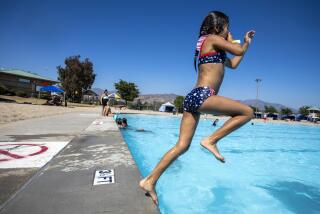Japan’s Children at Risk; Accidental Death Rate High
- Share via
TOKYO — They fall into bathtubs full of water. They tumble off their bikes without helmets. On family outings, they crawl freely around the car. All with deadly results.
Japan’s low crime rates and tight gun laws have helped make it safer for adults than many places. But for young children, the country is an accident waiting to happen.
“Parents and society in general have a low awareness about child accidents,” said Tetsuro Tanaka of the Japan Public Health Institute. “In terms of safety, Japan is behind.”
An institute study last year revealed an unsettling fact: Among 15 developed nations, Japan had the second-highest fatal accident rate for infants and a higher than average rate for preschoolers. New Zealand had the highest rate for infants.
The report and similar studies have spurred some action. Local health centers are starting to provide mothers with prevention tips. Parliament is working on a law requiring child seats to be used in cars.
In many ways, security is a high priority in Japan.
Subway loudspeakers warn commuter to stand away from the edge of the platform. At construction sites, guards wave neon batons to show pedestrians the way.
But when it comes to young children, the Japanese are hands off. Bicycle helmets are unheard of. In cars, kids are often seen sitting in the front--without even a seat belt.
“We’re just not used to them,” Mariko Shobayashi, 29, said of child car seats at a Tokyo park recently. “Kids and parents too--we don’t want to be bothered. It would just get in the way.”
Cramped Japanese houses are also packed with little dangers. Stairs are built at steep angles. Bathtubs--a top site of child accidents in Japan--tend to be sunk into the floor, surrounded by a low wall easily stumbled over by toddlers.
The public institute study, based on 1995 World Health Organization figures, found that Japanese children under a year old suffered 25.8 accidental deaths per 100,000 youngsters. That’s far above the country with the lowest rate, Norway, at 3.4, and even the United States’ 20.1.
Japanese toddlers ages 1 to 4 fare a bit better, at 11.1 deaths per 100,000--11th out of the 15 countries studied. Sweden was the safest, with 5.6 deaths. The United States was 14th, at 15.9, and New Zealand was worst, at 21.6.
Other smaller-scale Japanese studies revealed common, dangerous household habits: leaving infants unattended on couches, putting cigarettes and other small items in reach of children, keeping water--an expensive commodity in Japan--in the bathtub 24 hours a day for reuse for bathing or cleaning clothes.
Japan still has one of the lowest general infant mortality rates in the world, but the realization that it can be unsafe for children has been a jolt.
Tanaka, of the public health institute, says that while pediatricians have worked hard at curing illnesses, they haven’t seen prevention--of sicknesses or accidents--as part of their job.
“Doctors are just starting to realize that the accidental death rate is high in Japan,” he said.
Moves to stem that rate are gaining steam.
At the Child Accident Prevention Center in the Ikebukuro district in central Tokyo, a small-scale model of an apartment shows parents how to accident-proof their homes.
A strap keeps the refrigerator door shut and the sharp corners of the dining table are covered with small cushions. A plastic gate blocks the entrance to a staircase.
Yukiko Okuma, who helps run the center, said the idea grew out of a study 10 years ago of child accidents in the surrounding district. “We found out there were a lot of them,” she said.
Still, awareness about the dangers that everyday life presents to Japanese children has yet to filter down to many parents.
Shobayashi and other mothers gathered at a Tokyo park seemed more concerned with sensational threats--like crime--than the more common household dangers.
“I’m not so much worried about accidents,” said Kyoko Hosokoshi, 36, as her 5-year-old daughter rode a bicycle in the park. “I’m much more worried about kidnappings--I never let her out of my sight.”
(BEGIN TEXT OF INFOBOX / INFOGRAPHIC)
Dangers for Youngsters
Death rates from accidents for youngsters in 15 industrial nations:
Infants (up to 1 year old)
Norway: 3.4
Sweden: 5.9
Netherlands: 6.6
Britain: 7.1
Australia: 9.0
Austria: 10.8
Germany: 11.2
Switzerland: 12.1
Italy: 13.9
Canada: 15.2
Greece: 19.3
United States: 20.1
France: 21.8
Japan: 25.8
New Zealand: 40.8
****
Preschoolers (1 to 4 years old)
Sweden: 5.6
Britain: 5.6
Italy: 6.3
Netherlands: 6.6
Norway: 7.4
Germany: 9.3
France: 10.2
Canada: 10.3
Greece: 11.7
Japan: 11.7
Austria: 12.2
Switzerland: 13.2
Australia: 14.6
United States: 15.9
New Zealand: 21.6
Source World Health Organization
More to Read
Sign up for Essential California
The most important California stories and recommendations in your inbox every morning.
You may occasionally receive promotional content from the Los Angeles Times.













